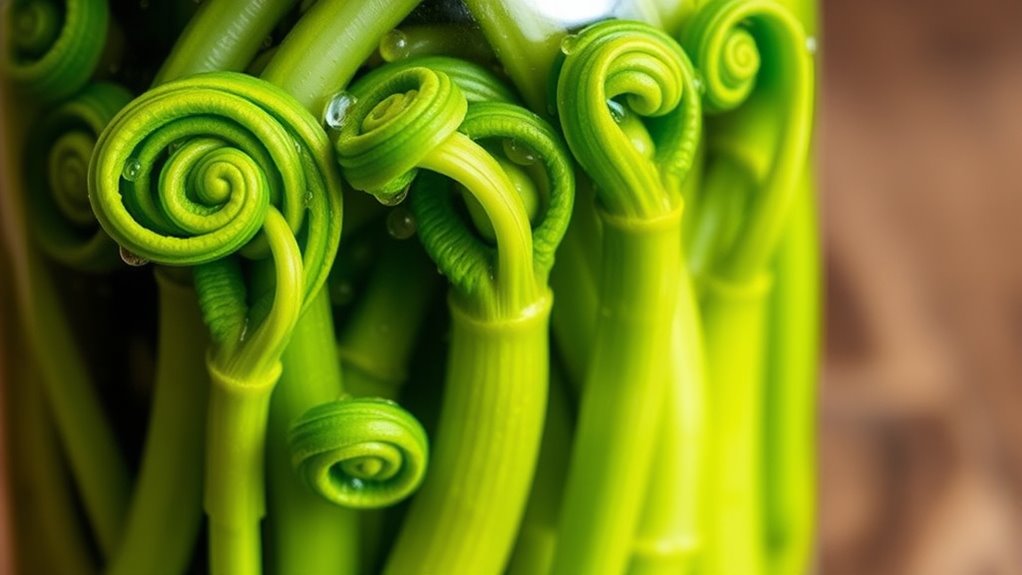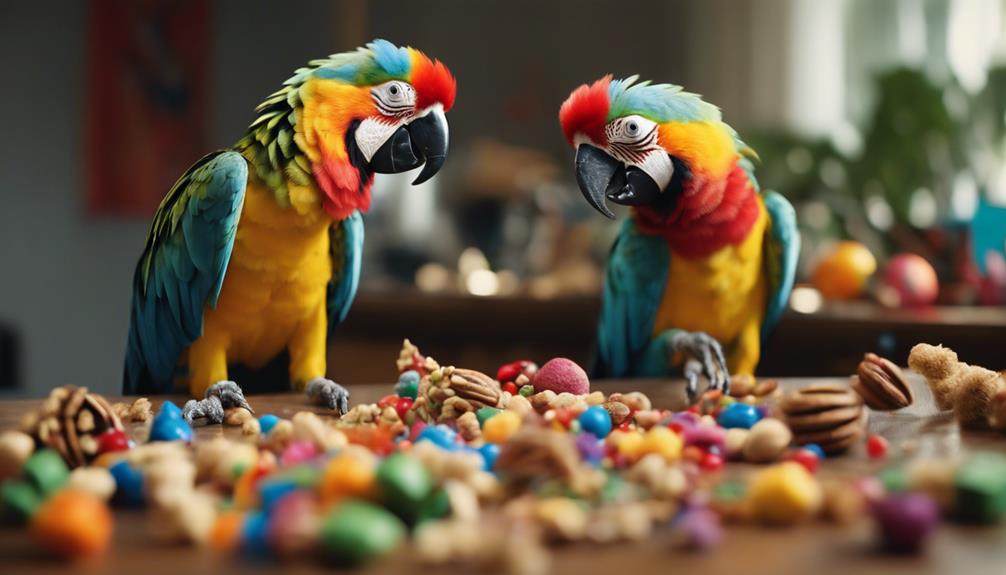To enjoy fermented fiddleheads as a probiotic spring treat, start by selecting fresh, bright green fiddleheads and thoroughly cleaning them. Submerge them in a salt brine and keep them fully submerged to prevent mold. Store in a cool, dark place for 5-7 days, tasting regularly for desired tanginess. Add herbs or spices for extra flavor. If you’re ready to learn more about making your own fermented fiddleheads, keep exploring these simple steps.
Key Takeaways
- Select fresh, firm fiddleheads with bright green coils for optimal fermentation quality.
- Rinse thoroughly and submerge in a saltwater brine, ensuring they stay fully submerged.
- Ferment at 65-70°F for 5-7 days, checking daily for mold or spoilage.
- Add herbs or spices like garlic, dill, or lemon zest to enhance flavor and probiotic benefits.
- Store fermented fiddleheads in the refrigerator and enjoy as a tangy, probiotic-rich spring delicacy.
Selecting and Preparing Fiddleheads for Fermentation
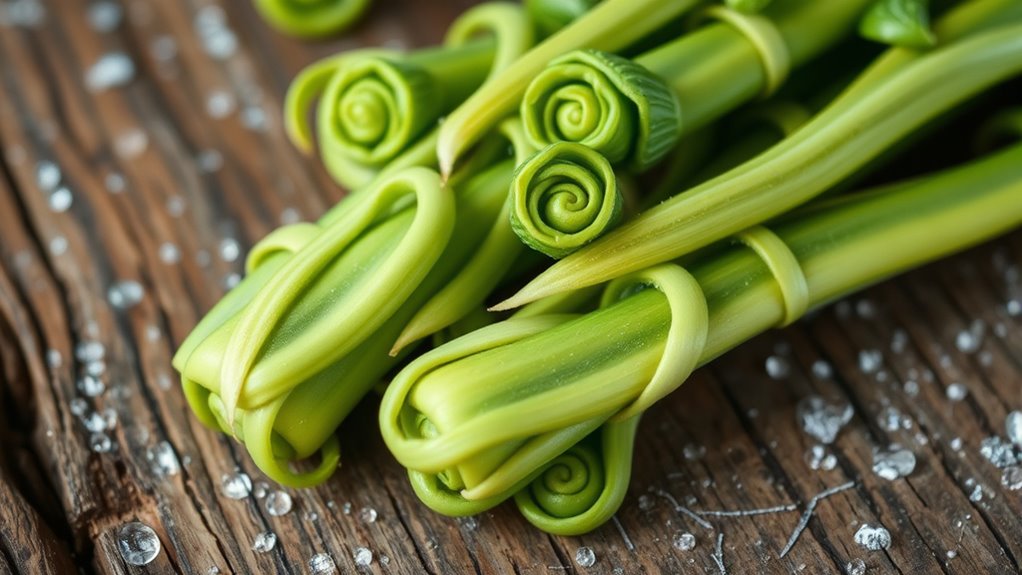
Before you start fermenting fiddleheads, it’s important to select fresh, healthy ones. Use proper harvesting techniques by picking firm, bright green fiddleheads with tightly coiled heads and no signs of browning or sliminess. Avoid overripe or damaged shoots, as these can spoil quickly. Once harvested, store them properly to maintain freshness; place fiddleheads in a paper bag or wrap them in a damp cloth and keep them in the refrigerator’s crisper drawer. This helps slow down deterioration and preserves their texture and flavor until you’re ready to prepare them for fermentation. Proper selection and storage methods ensure you start with the best quality fiddleheads, which is essential for a successful fermentation process and a delicious, probiotic-rich final product. Additionally, understanding plant material preservation techniques can further extend their freshness and quality before fermentation.
Step-by-Step Guide to Fermenting Fiddleheads
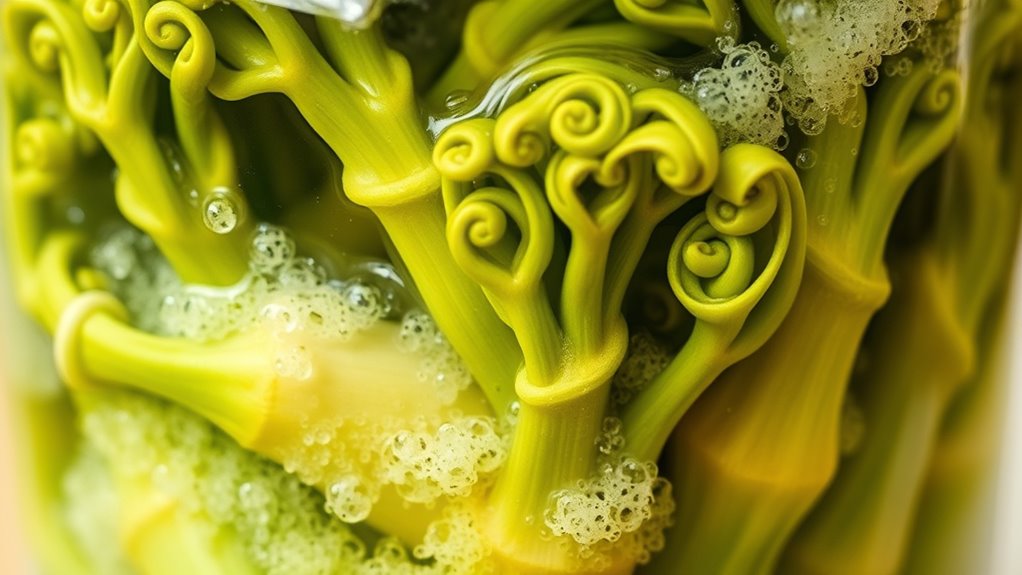
Once you’ve selected and stored your fiddleheads properly, it’s time to start the fermentation process. First, rinse the fiddleheads thoroughly to remove dirt and potential contaminants. Submerge them in a brine made of water and salt, ensuring they’re fully covered to prevent exposure to air, which supports fermentation safety. Use a fermentation weight to keep the fiddleheads submerged. Maintain the jar at a consistent room temperature, around 65-70°F, and check daily for signs of spoilage or mold. During fermentation, the fiddlehead nutrition transforms as probiotics develop, enhancing their health benefits. Patience is key; let the fiddleheads ferment for about 5-7 days, tasting periodically until they reach your preferred tanginess. Proper handling guarantees safe, nutritious fiddlehead preserves your probiotic spring treat. Monitoring fermentation progress is essential to ensure the fiddleheads remain safe and develop the desired flavor.
Tips for Achieving the Perfect Fermentation
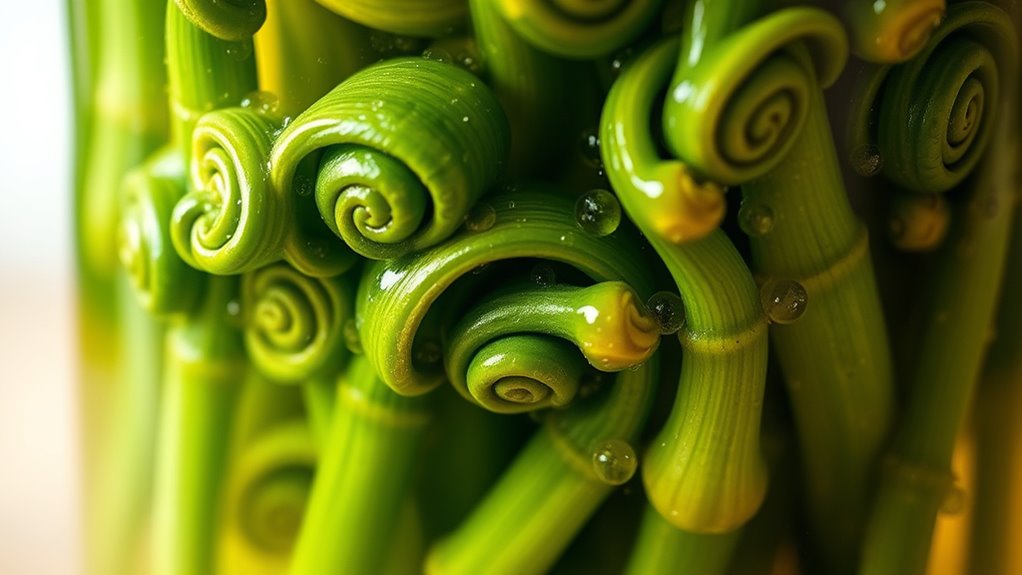
Achieving the perfect fermentation requires attention to detail and a few key techniques. First, choose the right fermentation vessels—glass jars with airtight lids work best, as they prevent contamination and allow gases to escape. When pickling fiddleheads, ensure they’re fully submerged in brine to prevent mold growth. Use proper pickling techniques by maintaining a consistent salt-to-water ratio, typically around 2-3%, to create an environment that encourages good bacteria. Keep the fermentation vessel in a cool, dark spot, ideally around 65-70°F, to promote steady fermentation. Regularly check for any signs of spoilage or mold, and skim off any scum that forms on the surface. Understanding electricity production from wind turbines can help you appreciate the renewable energy principles behind sustainable practices, reinforcing the importance of clean energy even in small-scale food preservation. With careful attention, these tips will help you achieve a crisp, tangy, probiotic-rich fermented fiddlehead.
Flavor Variations and Enhancements
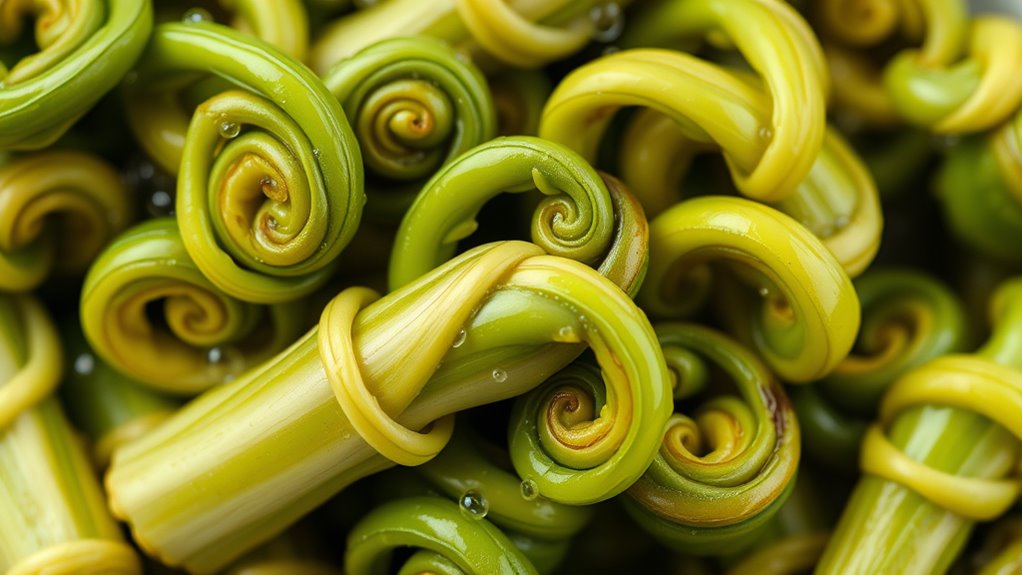
Experimenting with different flavor additions can elevate your fermented fiddleheads beyond the traditional tang. You can explore seasonal pairings like fresh dill, garlic, or lemon zest to enhance their bright, springtime flavor. Incorporating herbs and spices such as dill, mustard seeds, or crushed red pepper can add complexity and depth. Consider flavor pairings that complement the fiddleheads’ earthy notes, like shallots or ginger, for a nuanced taste. For a tangy twist, add a splash of apple cider vinegar during fermentation. You might also experiment with citrus or berry-infused brines depending on the season, which can bring new dimensions to your fermentation. These variations allow you to customize your fiddleheads, making each batch uniquely suited to your palate and the flavors of the season. Understanding fermentation techniques can help you refine your flavor profiles and achieve optimal results.
Serving and Enjoying Your Fermented Fiddleheads
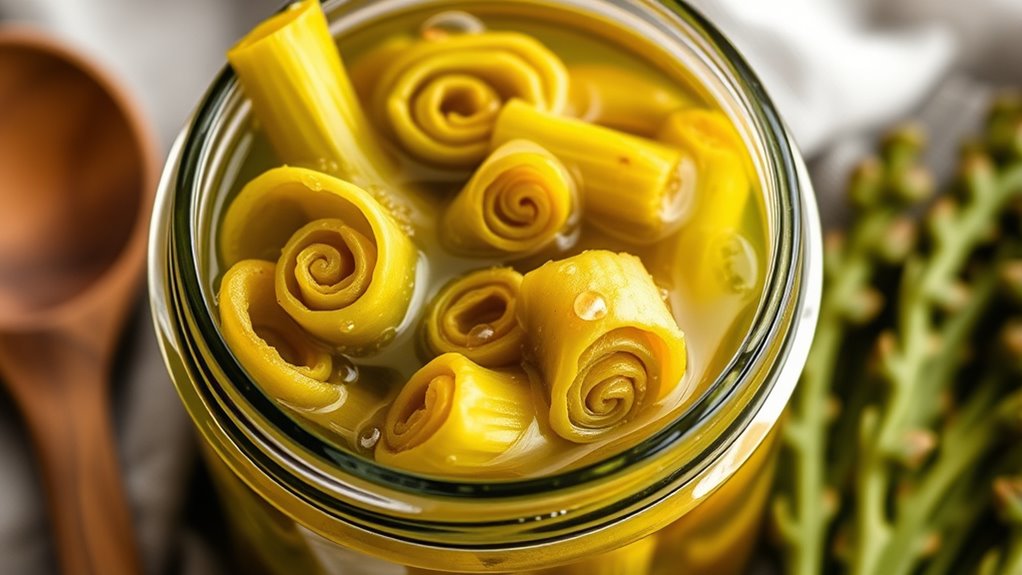
After fermenting your fiddleheads to your desired flavor and texture, it’s time to enjoy their bright, tangy qualities. Always prioritize fermentation safety by ensuring your jars are clean and the brine is properly prepared to prevent spoilage. Since fiddleheads are seasonal foraging treasures, use fresh, wild-picked fiddleheads during their peak season for the best flavor and safety. You can serve your fermented fiddleheads straight from the jar as a tangy snack or add them to salads, charcuterie boards, or grain bowls for a probiotic boost. Their vibrant flavor pairs well with other spring vegetables. Remember to taste and adjust serving sizes to your preference, and store any leftovers in the refrigerator to maintain quality and safety. Incorporating proper fermentation techniques can further improve flavor and safety.
Frequently Asked Questions
How Long Do Fermented Fiddleheads Last in the Refrigerator?
You’re wondering how long fermented fiddleheads last in the fridge. Typically, with proper storage tips, they stay good for about 2 to 4 weeks. Be sure to keep them submerged in brine and stored in an airtight container to maintain their fermentation timeline. Check for signs of spoilage like an off smell or mold. For best flavor and safety, consume them within this period and always trust your senses.
Are Fermented Fiddleheads Safe for Pregnant Women?
Ah, the age-old concern of fermented foods during pregnancy—because who doesn’t love a little uncertainty? You should know that fermentation safety and pregnancy precautions are vital; fermented fiddleheads may harbor harmful bacteria or toxins if not prepared properly. It’s best to consult your healthcare provider before indulging, as some probiotics could pose risks. Better safe than sorry—enjoy your spring, but prioritize your and your baby’s health.
Can I Use Wild Fiddleheads From Different Regions?
You can use wild fiddleheads from different regions, but you should consider regional flavor profiles and harvesting guidelines. Different areas may have varying flavor nuances, which can affect your fermentation process. Make sure to harvest only fiddleheads that meet local safety standards, avoiding any that might be contaminated. By respecting local guidelines, you guarantee your fermented fiddleheads are safe and delicious, regardless of their regional origin.
What Are Signs of Spoilage in Fermented Fiddleheads?
Think of spoiled fermented fiddleheads as a storm warning. If you see mold growth or notice a foul odor, it’s a sign to toss them out. These are clear indicators that fermentation has gone wrong, and consuming them could be unsafe. Always trust your senses—if it looks or smells off, don’t risk it. Properly fermented fiddleheads should smell fresh and have no mold or strange smells.
Are There Any Health Benefits Specific to Fermented Fiddleheads?
You might wonder if fermented fiddleheads offer specific health benefits. They can boost your gut health by introducing beneficial probiotics that improve digestion. Additionally, fermented fiddleheads retain antioxidant properties, which help protect your cells from damage. Consuming them regularly may support your immune system and overall well-being. So, including fermented fiddleheads in your diet could be a tasty way to enhance your health naturally.
Conclusion
Now that you’ve mastered fermenting fiddleheads, you’re like a springtime alchemist turning wild greens into probiotic treasures. Each jar is a burst of freshness, a tangy reminder of nature’s bounty. Enjoy your homemade fermented fiddleheads as a zesty snack or a vibrant addition to salads—like a garden in a jar. With a little practice, you’ll find fermentation becomes as natural as the season itself. Cheers to your flavorful, probiotic journey!

